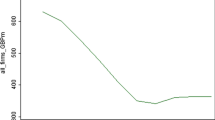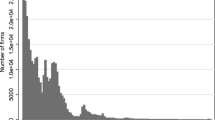Abstract
Based on a longitudinal database we test the "liability of adolescence" hypothesis which states that new firm hazard rates follow an inverted U-shaped pattern. That is, the hazard rate is low for the initial period; the end of adolescence is marked by a hazard maximum, from which the rate declines monotonically. We use a log-logistic model which shows that the "liability of adolescence" argument describes the hazard rates of new establishments for all two and three-digit industries fairly well. Further, the rate shows that the desegregation of industries matters, and considerable differences are found within and across two and three-digit low-, moderate- and high-tech industries. In assessing the effect of market environment conditions on risk we find that risk to be elevated in a relatively large number of two-digit low- and high-tech industries in the presence of scale economies, but it is substantially reduced in moderate-tech industries. By contrast, the hazard rate tends to be reduced for quite a large number of three-digit low-, moderate- and high-tech industries in comparison with the two-digit industries, indicating a longer adolescence. The influence of start-up size in reducing the hazard rate is apparently similar between two and three digit low-, moderate- and high-tech industries. The impact of market growth on the risk of failure is not much different for both two and three-digit low-, moderate- and high-tech industries.
Similar content being viewed by others
References
Acs, Z. J. and D. B. Audretsch, 1990, Innovative and Samll Firms, Cambridge, MA: MIT Press.
Aldrich, H. E. and E. Auster, 1986, ‘Even Dwarfs Started Small: Liabilities of Size and Age and their Strategic Implication, Research in Organizational Behavior 8, 165–198.
Aldrich, H. E., B. Rosen and W. Woodward, 1987, ‘The Impact of Social Networks on Business Founding and Profit: A Longitudinal Study’, in N. Churchill, J. Hornaday, O. J. Krasner and K. Vesper (eds.), Frontiers of Enterpreneurship Research, Wellesley: Babson College, pp. 154–168.
Aldrich, H. E., Staber, C. Zimmer and J. J. Beggs, 1990, ‘Minimalism and Oragnizational Mortality: Patters of Disbanding Among U.S. Trade Associations, 1900–1983’, in J. V. Singh (ed.), Organizational Evolution, Newbury Park: Sage, pp. 21–52.
Aldrich, H. E. and G. Wiedenmayer, 1990, ‘From Traits to Rates: An Ecological Perspective on Organizational Foundings’, Department of Sociology, University of North Carolina, Chapel Hill (mimeo).
Audretsch, D. B., 1995, Innovation and Industry Evolution, Cambridge, Mass.: MIT Press.
Audretsch, D. B., 1991, ‘New-Firm Survival and the Technological Regime’, Review of Economics and Statistics 73, 441–450.
Audretsch, D. B. and T. Mahmood, 1995, ‘New Firm Survival: New Results Using a Hazard Function’, Review of Economics and Statistics 77, 97–103.
Audretsch, D. B. and T. Mahmood, 1994, ‘The Rate of Hazard Confronting New Firms and Plants in US Manufacturing, Review of Industrial Organization 9(1), 41–56.
Baldwin, J. R., 1995, The Dynamics of Industrial Competition, Cambridge: Cambridge University Press.
Blooseld, H.-P, A. Hamerle and K. U. Mayer, 1989, Event History Analysis, Statistical Theory and Application in the Social Sciences, Mahwah, New Jersey: Lawarence Erlbaum Associates, Publishers.
Blossfeld, H.-P. and G. Rohwer, 1995, Techniques of Event History Modeling, New Approaches to Causal Analysis, Mahwah, New Jersey: Lawrence Erlbaum Associates, Publishers.
Brüderl, J., 1992, ‘Organizational Mortality and the Liability of Adolescence’, Institut für Soziologie, Universität München (mimeo).
Brüderl, J., 1991, ‘Bell Shaped Duration Dependence in Social Processes: A Generalized Log-Logistic Model’, Institut für Soziologie, Universität Bern.
Brüderl, J. and R. Schüßler, 1990, ‘Organizational Mortality: The Liabilities of Newness and Adolescence’, Administrative Science Quarterly 35, 530–547.
Comanor, W. S. and T. A. Wilson, 1967, ‘Advertising, Market Structure, and Performance’, Review of Economics and Statistics 49, 423–440.
Dixit, A., 1989, ‘Entry and Exit Decisions under Uncertainty’, Journal of Political Economy 97, 620–638.
Doms, M., T. Dunne and M. J. Roberts, 1995, ‘The Role of Technology use in the Survival and Growth of Manufacturing Plants’, International Journal of Industrial Organization 13(4), 523–542.
Dunne, P. and A. Hughes, 1994, ‘Age, Size, Growth and Survival: UK Companies in the 1980s’, Journal of Industrial Economics 42, 115–140.
Dunne, T., M. J. Roberts and L. Samuelson, 1989, ‘The Growth and Failure of U.S. Manufacturing Plants’, Quarterly Journal of Economics 104(4), 671–698.
Dunne, T., M. J. Roberts and L. Samuelson, 1988, ‘Patterns of firm Entry and Exit in U.S. Manufacturing Industries’, Rand Journal of Economics 19(4), 495–515.
Fichman, M. and D. A. Levinthal, 1991, ‘Honeymoons and the Liability of Adolescence: A New Perspective on Duration Dependence in Social and Organizational Relationships’, Academy of Management Review 16, 442–468.
Freeman, J. G., R. Carool and M. T. Hannan, 1983, ‘The Liability of Newness: Age Dependence in Organizational Death Rates’, American Sociological Review 48, 692–710.
Granovetter, M. S., 1983, ‘The Strength of Weak Ties: A Network Theory Revisited’, in R. Collins (ed.), Sociological Theory, San Francisco: Jossey-Bass.
Hall, B. H., 1987, ‘The Relationship between Firm Size and Firm Growth in the U.S. Manufacturing Sector’, Journal of Industrial Economics 35, 583–605.
Hannan, M. T. and J. Freeman, 1989, Organizational Ecology, Cambridge, MA: Harvard University Press.
Hoppenhayan, H., 1992, ‘Entry, Exit and Firm Dynamics in Long Run Equilibrium’, Econometrica 60, 1127–1150.
Jaffe, A. B., 1989, ‘Real Effects of Academic Research’, American Economic Review 79(5), 957–970.
Kiefer, N. M., 1988, ‘Economic Duration Data and Hazard Functions’, Jounral of Economic Literature 26, 646–679.
Mahmood, T., 1996, ‘Ñberlebenschancen neugegründeter Berliner Betriebe: Eine Auswertung der Gewerben-und-Abmeldungen der Industrie-und Handelskammerdaten für den Zeitraum 1981–1990, Wissenschaftszentrum Berlin für Sozialforschung Discussion Paper FS IV 96-6.
Mahmood, T., 1992, ‘Does the Hazard Rate of New Plants 236 Talat Mahmood Vary Between High-and Low-Tech Industries?’, Small Business Economics 4(3), 201–210.
Mata, J. and P. Portugal, 1994, ‘Life Duration of New Firms’, Journal of Industrial Economics 27(3), 227–246.
Mata, J., P. Portugal and P. Guimaraes, 1995, ‘The Survival of New Plants: Start-up Conditions and Post-entry Evolution’, International Journal of Industrial Organization 13(4), 459–481.
Scherer, F.M. and D. Ross, 1990, Industrial Market Structure and Economic Performance, 3rd ed., Boston: Houghton Mifflin.
Singh, J. V. and C. J. Lumsden, 1990, ‘Theory and Research in Organizational Ecology’, Annual Review of Sociology 16, 161–195.
Singh, J. V., D. J. Tucker and R. J. House, 1986, ‘Organizational Legitimacy and the Liability of Newness’, Administrative Science Quarterly 31, 71–193.
Stinchcombe, A. L., 1965, ‘Social Structures and Organisations’, in J. G. March (ed.), Handbook of Organizations, Chicago: Rand McNally, pp. 142–193.
Wagner, J., 1994, ‘Small Firm Entry in Manufacturing Industries’, Small Business Economics 5(3), 211–214.
Weiss, L. W., 1964, ‘The Survival Techique and the Extent of Suboptimal capacity’, Journal of Political Economy 72(3), 246–261.
Williamson, O. E., 1981, ‘The Economics of Organizations: The Transaction Cost Approach’, American Journal of Sociology 87, 548–577.
Williamson, O. E., 1975, Markets and Hierarchies, New York: Free Press.
Author information
Authors and Affiliations
Rights and permissions
About this article
Cite this article
Mahmood, T. Survival of Newly Founded Businesses: A Log-Logistic Model Approach. Small Business Economics 14, 223–237 (2000). https://doi.org/10.1023/A:1008116207175
Issue Date:
DOI: https://doi.org/10.1023/A:1008116207175




